
| KIT #: | SH 72241 |
| PRICE: | £27.50 or Approx $45.00 |
| DECALS: | Two options |
| REVIEWER: | Chris Peachment |
| NOTES: | Short run kit |

| HISTORY |
I can do no better than quote Scott Van Aken's summary in his preview
piece on this website, except to add that this version is a floatplane, although
it includes the original wheeled undercarriage and torpedo, which will be very
handy for the spares box.
The Vickers Vildebeest and the similar Vickers Vincent were two very
large two- to three-seat single-engine British biplanes designed and built by
Vickers and used as a light bomber, torpedo bomber and in the army cooperation
roles. While first flown in 1928, it remained in service at the start of the
Second World War, with the last Vildebeests flying against Japanese forces over
Singapore and Java in 1942.
Designed against Air Ministry Specification 24/25 for the RAF, for a
land-based torpedo bomber to replace the Hawker Horsley, the prototype
Vildebeest, the Vickers Type 132, was first flown in April 1928, powered by a
Bristol Jupiter VIII radial engine. After initial evaluation, the Vildebeest was
shortlisted for evaluation with the Blackburn Beagle and Handley Page Hare. As
the Jupiter VIII was prone to vibration, a second
 prototype,
the Vickers Type 204 was fitted with a Armstrong Siddeley Panther engine, and
after further testing, the Vickers design was confirmed as the winner of the
contest. Engines problems continued, however, which were solved by fitting a new
version of the Jupiter, which later became known as the Bristol Pegasus.
prototype,
the Vickers Type 204 was fitted with a Armstrong Siddeley Panther engine, and
after further testing, the Vickers design was confirmed as the winner of the
contest. Engines problems continued, however, which were solved by fitting a new
version of the Jupiter, which later became known as the Bristol Pegasus.
The Vildebeest had an all-metal, fabric-covered airframe, with
single-bay unstaggered wings. An initial production order was placed in 1931 for
nine aircraft, with the first production aircraft flying in September 1932. More
production followed, with major production being of the Vildebeest III version,
which added a third crew member, with 150 built for the RAF. The Mark IV
introduced the much more powerful (825 hp (615 kW)) Bristol Perseus Sleeve valve
radial engine enclosed in a NACA cowling, which significantly improved
performance, maximum speed increasing to 156 mph (251 km/h) and rate of climb to
840 ft/min (4.3 m/s). The Perseus had overheating problems, and was unsuitable
for tropical service, and production was limited to 18 aircraft, which served
with the home based squadrons.
As with many aircraft designs during the mid war period, the Vildebeest
was exported and build under license. One of the licensees was CASA in Spain who
built a modified version powered by a Hispano-Suiza V-12 water-cooled engine. A
total of 25 were built in Spain with two additional being supplied as knock-down
aircraft from the UK. These were all operated by the Spanish Navy and were
designed to be used as torpedo bombers. However, as often happens, they were
adapted for land bombing as well. They could be operated either on wheels or on
floats. Because of their water operation, they had larger rudders from the
British Vildebeest.
| THE KIT |
Two decal options:
1. CASA of the Spanish Republican Air Force in 1938. This is cited as
having the complicated wave pattern camouflage of white and grey painted over
the bare silver dope. This was the aircraft I chose to do because I had never se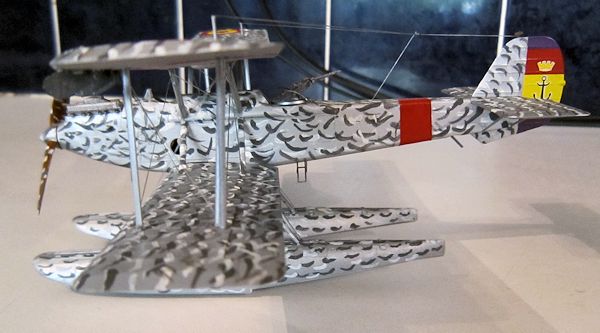 en
camouflage like it before. Although I could find only one black and white
picture on the internet to back it up.
en
camouflage like it before. Although I could find only one black and white
picture on the internet to back it up.
2. CASA of the Spanish Navy Air Force in 1936. This has an appealing
unit marking of a blue and yellow dolphin on the nose, but is otherwise plain
silver dope.
There are etched and resin parts and one small clear windscreen. The
moulding is excellent, and while it is a short run kit, it is well up to the
general standards
of mainstream injected kits. With the caveat that it is
a biplane and needs complex rigging, and there is a lot of delicate etched
detail on the exterior, the experienced modeler will have little problem with
it.
| CONSTRUCTION |
Construction began as usual with the interior, which has two separate
sub-assemblies for the two cockpits. I chose not to use the small etched details
for the sides of the cockpits since they can't be seen. I am not one of those
modellers who thinks “it is nice to know they are there” even if invisible. What
I think, as the years advance, is that if it can't be seen then it is a waste of
time, and that time saved can be put to good use making more models.
This is probably the first
time with a short run kit that I didn't have to sand
down the edges of the cockpit interior to make it fit in the fuselage. It is
always a tedious and messy business and I wish more
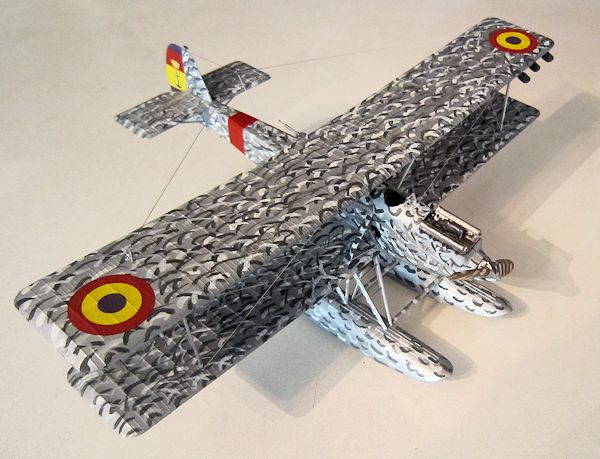 manufacturers
paid attention to it.
manufacturers
paid attention to it.
On the basis that it was originally a British machine, and also because
the instructions recommended it, I painted the interiors British cockpit green,
with some careful wear and tear from dry brushing dark grey. Very little can be
seen of it however.
Once the seats were dried, the two fuselage halves were cemented and the
seams were sanded smooth. No filler was needed.
It was now that I chose to put the floats together, partly because they
are complex and delicate, partly because I thought I would try the wave
camouflage here first, and see if it came out all right. If it had failed than I
would have reverted to the overall silver dope option. Once all the struts were
set at what looked like the right angle, I sprayed it overall Humbrol silver 11.
(Incidentally Humbrol paints have improved by leaps and bounds lately. I suspect
because they have been returned to UK manufacturing sources rather than in the
far East).
| COLORS & MARKINGS |
Once dried I took a deep breath, along with some Vallejo off-white, and
brushed on a few wavelets in a random fashion, following the box art and the one
photo mentioned below. They are roughly a flattened U-shape and flow lengthwise
along the float, though not in rigid lines. I then tried some medium grey from
Lifecolor range, possibly Dark Gull Gray though I am not sure as the label had
come off. I
filled in some waves between the white ones, but then made a few
of them overlap. The results pleased me well enough to continue with this
scheme.
Setting the floats aside for later, I sprayed the whole of the fuselage
and separate wings with silver and then embarked on a hand paintings session of
white and grey wavelets. A week of evenings later, I was
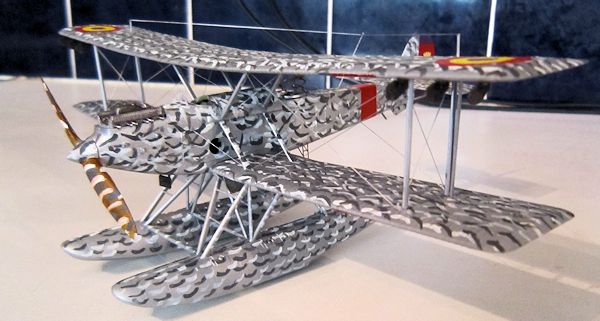 fighting
off sea-sickness, but the finished result does look distinctive if nothing else.
fighting
off sea-sickness, but the finished result does look distinctive if nothing else.
Keeping the wings separate, I masked off the red bands used by the
Republican Air Force in the Civil War, and painted them Tamiya Red, which seems
to contain some blue in it and is one of my favourite shades of red. I also use
it on Ferraris. Roundels were applied, which needed no setting solution. I also
took the opportunity to do the fin, which is admirably mounted on the sprues at
three points which will not show when cut off. For the tricolour fin markings I
used a lot of micro-set, to ensure they wrapped around the edges well. The
anchor and crown were then applied separately.
(A thought occurs at this point. Why is a Republican aircraft sporting a
crown emblem? My knowledge of the Spanish Civil War is not detailed enough to
provide an answer, but if any reader can enlighten, then I would be interested.)
Once all was dry, a coat of satin varnish took the edge off all the hand
painting. The bottom wings can be mated to the fuselage, and strut work can
commence.
| FINAL CONSTRUCTION |
I say this lightly, because I am an old hand with biplanes. But I should
have known better than to count my chickens. From having behaved impeccably, the
kit now turned vicious. After cementing the cabane struts in place, I mounted
the upper wing on them and left overnight to set. The next day revealed the main
struts as too short by a large amount. Cursing at the wasted time, I nipped off
the cabane struts and mounted the interplane struts on the bottom wing instead.
Here again the struts seem to be of uneven length, and the top wing wouldn't sit
on all four, but only three at a time. Instead of chopping lengths off the
struts, which is always nerve racking, I drilled the mounting holes in the wing
a little deeper and that took up the differing lengths of strut well enough.
With a little extra weight on the top wing in the shape of Humbrol tins, they
set well overnight.
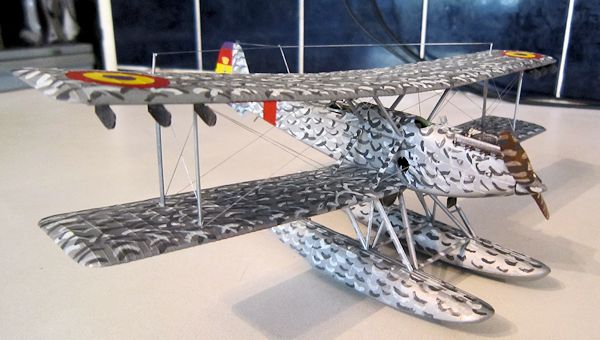 The
cabane struts were then offered up using tweezers and found to fit perfectly
well, except for the forward two which required slight trimming.
I
cannot offer an explanation for this anomaly, other than perhaps some wing
warping which eventually righted itself. It was just one of those odd things
which happens in modeling. Though it is possible I originally put the cabanes on
the wrong way round.
The
cabane struts were then offered up using tweezers and found to fit perfectly
well, except for the forward two which required slight trimming.
I
cannot offer an explanation for this anomaly, other than perhaps some wing
warping which eventually righted itself. It was just one of those odd things
which happens in modeling. Though it is possible I originally put the cabanes on
the wrong way round.
The horizontal tail went on easily, and I made the struts of plastic
rod, rather than use the kit's ones which had seams. The fin was reserved until
after rigging, as it was easier to manoeuvre the aircraft around without it.
For rigging I used elastic mending thread, painted silver with a felt
tip marker pen. Each end was secured with a tiny drop of superglue gel applied
with a sharpened toothpick. I find the gel makes life a lot easier, as it is
possible to control the small amount much more precisely than the usual
superglue, which can run all over the place. Also, elastic thread soaks it up
and sets
very quickly, which is a bonus when rigging.
Once the wings were rigged, I painted the engine which is one block of
resin, silver with some gunmetal and rust dry-brushing and inserted it into the
hole in the fuselage, which presented no problems.
All that was left now was the addition of small and highly vulnerable
photo-etched details. So I offered up the float assembly to the fuselage and
wing roots, and found it fitted well, except that there are no location holes
underneath. Rather than try and drill them without a plan, I very carefully
sanded the locating pins off the tops of the float struts, and then glued the
whole rig in place and let it set overnight. It is still holding up well.
Then the etched details. The scarff ring is mounted in very small etched
uprights, and these need careful bending. Once in place, the nicely detailed
Lewis gun can be painted black, dry brushed with gunmetal, and glued to the
scarff ring. The resin radiators were also dry brushed gunmetal and placed
beneath the wing roots. And the oil cooler painted black and superglued under
the nose.
Those six odd-looking lobes are fitted under each upper wing towards the
tip. I am not sure what they are, but I suspect something to do with actuating
the leading edge slats. Or perhaps they are some kind of counter-weight.
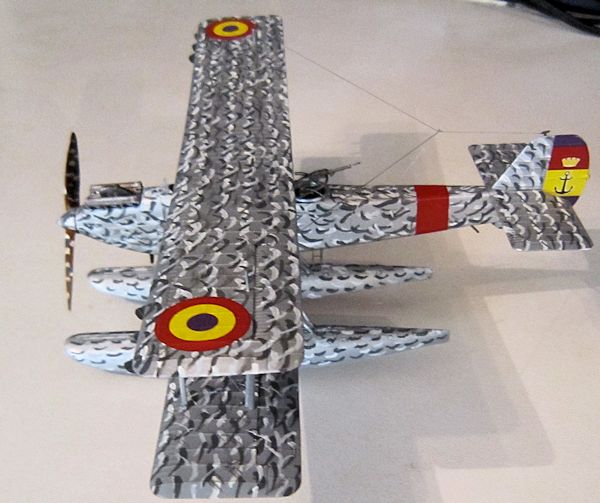 The
fin was fixed in place with no trouble, and the very small T-shape thingy glued
on top. Now the tricky business of the aerials can be done. I used one length of
elastic thread from the fin mount to the starboard wing, with a little slack in
it. The dividing point, a three-way junction, about an inch and a half forward
of the fin, then had another length of thread glued to it, and this was
stretched to the port wing. Then another short length was glued to the upper
fuselage, behind the rear cockpit, and gently coaxed up to the dividing point on
the three part aerial. It is easier to look at the picture than to describe.
The
fin was fixed in place with no trouble, and the very small T-shape thingy glued
on top. Now the tricky business of the aerials can be done. I used one length of
elastic thread from the fin mount to the starboard wing, with a little slack in
it. The dividing point, a three-way junction, about an inch and a half forward
of the fin, then had another length of thread glued to it, and this was
stretched to the port wing. Then another short length was glued to the upper
fuselage, behind the rear cockpit, and gently coaxed up to the dividing point on
the three part aerial. It is easier to look at the picture than to describe.
Things are now very delicate, and the aircraft is best handled at the
nose, before the prop is put in place. The propeller was wooden, but with the
wave camouflage on it as well. I gave the blades a coat of medium brown and a
top coat of Tamiya Clear Orange, did the spinner in silver and then hand painted
the wave camouflage over the whole thing, gave it a coat of satin varnish and
mounted it in place.
The tiny windscreen can be fixed in place using Humbrol's excellent
Clearfix.
Two tiny little stalks were glued under the wings toward the tips. Since
they have eyelets, I would guess they were tie-downs for the aircraft when left
in the open. They are so vulnerable, they will be bound to be knocked off soon.
And the same with the two rudders which are mounted on the rear of the
floats. The whole things sits well enough on the forward part of the floats, but
it only needs to be rocked back a little to knock the rudders off. I don't think
they will last either. I left them off, or rather they were knocked off, while
handling the model for the photographs. Rest assured they are now back in place.
After all that it was a case of resting it very gently on a white surface for all the pictures to be taken, and then gingerly placing it in a position on my shelves where it won't be disturbed or collect dust. This is one very delicate kit, and ought to have a glass case to itself.
| CONCLUSIONS |
I wanted this kit because I had an old vac form of the Vildebeest in
British markings of the 30s of which I am fond because it is so plug ugly. The
inline Hisso engined version is marginally better looking, though it is still no
oil painting. It is incredible to think that it went into battle against the
Japanese in Singapore in 1942, when it was hopelessly obsolete. One can only
salute the bravery of the pilots and crews.
I am also very fond of floatplanes and I can't explain why, except to
suggest they make a nice change from wheels.
The
Spanish Civil War always offers a good choice of colourful markings which are
out of the norm.
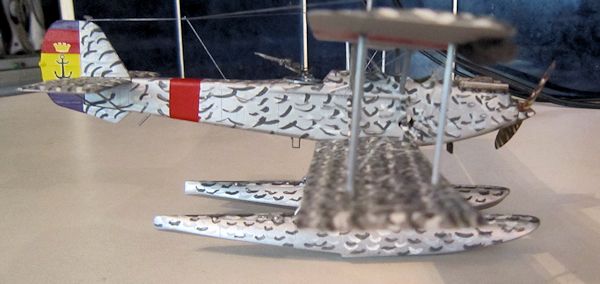 If
you want a Vickers Vildebeest or a CASA in this case, then this is the only
injection kit I know of. It isn't cheap but it is good value when you look at
all the detail. I wouldn't recommend it to a beginner, for two reasons. The
strut work can get frustrating because of strut fit problems. Once sorted out
though, it is fine. But then you have all the etched detailing to add and that
leaves the whole thing very vulnerable.
If
you want a Vickers Vildebeest or a CASA in this case, then this is the only
injection kit I know of. It isn't cheap but it is good value when you look at
all the detail. I wouldn't recommend it to a beginner, for two reasons. The
strut work can get frustrating because of strut fit problems. Once sorted out
though, it is fine. But then you have all the etched detailing to add and that
leaves the whole thing very vulnerable.
You will find the usual frustrations of knocking off bits of etch as you
proceed to the next bits to be superglued in awkward spots. Never mind, because
the more difficulty you overcome, the more proud you will be of the final
result. I find these days that unless I have done a fair amount of carving,
sanding and tricky detailing then I don't feel the kit is 'mine'. Those Japanese
kits that fall together out of the box, admirable as they are, aren't quite
'mine' for that same reason.
My one regret is that I couldn't use that yellow and blue dolphin on the nose, because it is such a lovely mascot. I may well add it in any case, on the basis that there is so little photographic evidence of this aircraft, it is possible it might have been used. Who is to say not?
Chris Peachment
August 2013
If you would like your product reviewed fairly and fairly quickly, please contact the editor or see other details in the Note to Contributors.